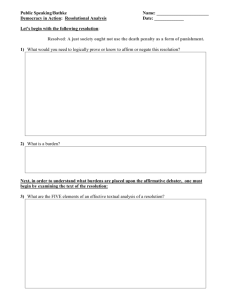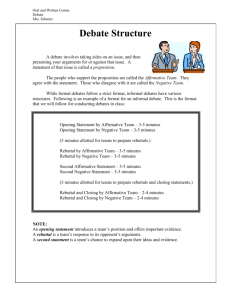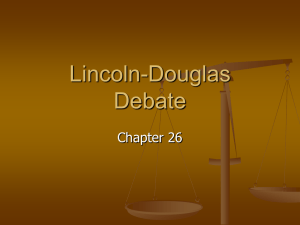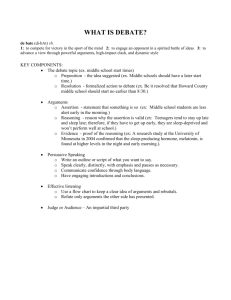Finding your way through Debate…
advertisement
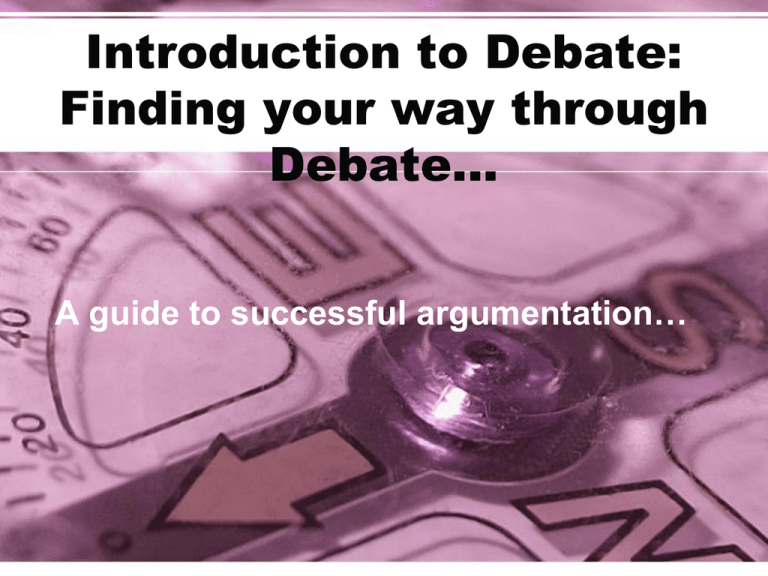
Introduction to Debate: Finding your way through Debate… A guide to successful argumentation… TYPES OF DEBATE 1. Value Debates (about the priority of different values) 2. Policy Debates (whether or not to take a particular action) 3. Fact Debates (proving a fact such as that UFOs exist) 4. Parliamentary Debates (based on a political premise with persuasive speeches) 5. Panel Debates (moderator asks questions of several political figures) 6. Public Forum Debates (teams debate controversial topics from newspaper headlines) Lincoln-Douglas Debate History of the LincolnDouglas Debate • In 1859, Senator Stephen A. Douglas was up for reelection to his Illinois Senate seat. • His opponent was Abraham Lincoln. • During the campaign, the two men faced off in seven debates in different Congressional Districts (ones that Douglas had not yet visited). Format of the original Lincoln-Douglas Debates • Opening statement (1 hour) [This alternated with each debate.] • Rebuttal statement (1 ½ hours) • First speaker rebuttal of second speaker (30 min.) Modern format of LincolnDouglas Debates • Affirmative position debater presents constructive debate points (6 minutes) • Negative position debater cross-examination affirmative points (3 minutes) • Negative position presents constructive debate points (7 minutes) • Affirmative position cross-examines negative points (3 minutes) • Affirmative position offers first rebuttal (4 minutes) • Negative position offers first rebuttal (6 minutes) • Affirmative position offers second rebuttal (3 minutes) Constructing an argument RESOLVED: Student parking privileges should be contingent on academic performance. Your job: • Write down one argument for each side of the issue. • You MUST supply a reason (evidence) WHY you think these arguments are true. Group Task: • Together, determine what your three main arguments are and WHY you believe these arguments are true. • Everyone records your group’s arguments on the handout. • Choose a moderator to present your group’s arguments. Final Questions: • Why is each argument important? • How does each argument explicitly support your side? • How does it affect people? Structure of an argument: 1. Claim: a statement of possible truth 2. Warrant: gives support for the argument as to why it is true a. Analytical warrant: logical reasons for the truth b. Empirical warrant: statistics and examples from the real world c. Psychological warrants: explains how people act in certain situations backed up with psychological studies 3. Impact: importance of the argument in terms of how it proves claim true or how the argument affects people What is a value? • A principle, standard, or quality considered worthwhile or desirable What are some principles that most people value? What is a statement of value? • It is more about what ought to be true than what is actually true. • They tend to be more subjective as different people/cultures value different things. • They tend to reference larger metaphysical concepts such as “justice” and “morality.” What is the difference between a statement of value and one of fact? • To affirm a statement of fact, you would have to make an absolute statement about the truth of the statement, with NO exceptions. • To affirm a statement of value, you show that the statement is true “as a matter of principal”, with small exceptions that do not invalidate the overall claim. Resolved: In a Democratic society, felons ought to retain the right to vote. First, analyze the text: 1. Understand the definitions of words in the resolution. 2. Understand the type of resolution at hand. 3. Understand the context, if any, provided by the resolution. 4. Understand the actor and action of the resolution. 5. Recognize the evaluative term of the resolution. 1. Define key words: • Resolved: In a Democratic society, felons ought to retain the right to vote. 2. Identify the type of resolution: Type 1: COMPARATIVE (“x” is more desirable than “y”) Requires you to examine both sides and show why one ought to preference one thing as opposed to another thing. 2. Identify the type of resolution: Type 2: ABSOLUTE (“x” action is just) Requires you to prove that the action or idea being put forward is correct. 2. Identify the type of resolution: Type 3: SUPERLATIVE (“x” is the best form of government) Requires you to defend one notion as being preferable to all other options. You must focus on that advantages of the notion and why the possible harms are not that important. 2. Type of Resolution • Resolved: In a Democratic society, felons ought to retain the right to vote. 3. What is the context? Look for clauses that show the context of the value statement. Ask these questions: 1. Does the resolution provide a specific context? 2. How do these contexts clarify the conflict of the resolution? 3. How do these contexts suggest burdens for what the affirmative or negative debater has to prove? 3. Contexts • Resolved: In a Democratic society, felons ought to retain the right to vote. 4. Who is the actor? What is the action? The actor is the agent/person/entity that will presumably carry out the action in the affirmative world. (i.e.: a governement, the individual, society, the international community, etc.) The action is what the actor of the resolution will do in the affirmative world. 4. Actor/Action • Resolved: In a Democratic society, felons ought to retain the right to vote. 5. What is the evaluative term or phrase? • Evaluative terms pose the moral, legal, or ethical question of the resolution. For example: – It is morally permissible to kill one innocent person to save the lives of more innocent people. – In the United States, jury nullification is a legitimate check on government. – International leaders ought to cancel the debt of highly indebted poor countries. – Capitalism is the most just form of economic system. 5. Evaluative Term • Resolved: In a Democratic society, felons ought to retain the right to vote. Final Question • Resolved: In a Democratic society, felons ought to retain the right to vote. Resolution Evaluation • These are the resolutions for our first team debate: – Public high school students in the United States ought not be required to pass standardized exit exams to graduate. – A just society ought not to use the death penalty for a form of punishment. – Juveniles charged with violent crimes should be tried and punished as adults. – In matters of collecting military intelligence, the ends justify the means. – Military conscription is unjust in the United States. Resolution Evaluation • Structure of the first debate: • Affirmative definition of terms and first argument • Negative definition of terms and first argument • Affirmative rebuttal and second argument • Negative rebuttal and second argument • Affirmative rebuttal and third argument • Negative rebuttal and third argument • Affirmative summary and closing statement • Negative summary and closing statement 3 minutes max for each stage of the debate.
